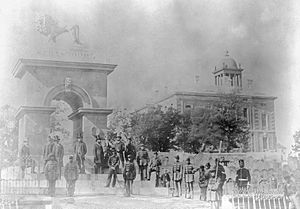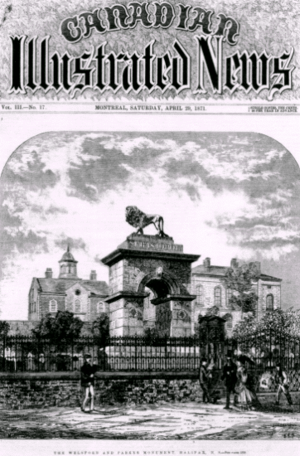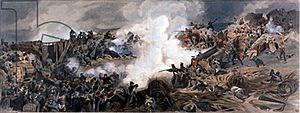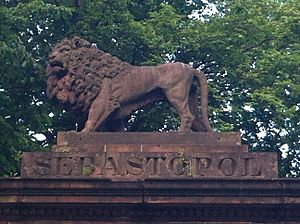Sebastopol Monument facts for kids
Quick facts for kids Welsford-Parker Monument |
|
|---|---|
| Canada | |

Sebastopol Monument
|
|
| For British victory in the Crimean War and the Siege of Sevastopol | |
| Unveiled | 1860 |
| Location | Old Burial Ground, near |
| Designed by | George Lang (builder) |
The Sebastopol Monument is a special arch found in the Old Burial Ground in Halifax, Nova Scotia, Canada. It's also known as the Crimean War monument or the Welsford-Parker Monument. This monument was built to remember the Siege of Sevastopol (1854–1855), a very important battle in history.
Built in 1860, it is the fourth oldest war monument in Canada. It's also the only monument in North America that honors the Crimean War. The arch and a lion statue were created by stone sculptor George Lang. They celebrate Britain's victory in the Crimean War and the brave Nova Scotians who fought in it.
Contents
The Crimean War and Sevastopol
Britain and France invaded Crimea in 1854. Their goal was to destroy the Russian naval base at Sevastopol. They landed with 50,000 soldiers, planning a quick march to the capital.
However, the British forces fought for a whole year against the Russians. The monument lists the battles they fought to reach Sevastopol: "Alma" (September 1854), "Balaklava" (October 1854), "Inkerman" (November 1854), "Tchernaya" (August 1855), "Redan" (September 1855), and finally, "Sebastopol" (September 1855). The fight for Sevastopol was the final, bloody part of the costly Crimean War.
During the Victorian era, these battles were often remembered. The Siege of Sevastopol inspired famous works like Leo Tolstoy's Sebastopol Sketches. The Battle of Balaklava became famous from Alfred, Lord Tennyson's poem "The Charge of the Light Brigade". It also inspired Robert Gibb's painting Thin Red Line. A famous nurse, Florence Nightingale, helped treat the wounded from these battles.
Remembering Nova Scotian Heroes
The monument in Nova Scotia also honors two men from Halifax. They were Major Augustus Frederick Welsford and Captain William Buck Carthew Augustus Parker. Both died in the Battle of the Great Redan in 1855. This battle was part of the Siege of Sevastopol (1854–1855).
The monument was officially revealed on July 17, 1860. It cost 500 pounds to build. In 1855, Nova Scotian Joseph Howe worked hard to get troops to join the war. Another Nova Scotian, Sir William Williams, 1st Baronet, of Kars, also became famous. He was a commander during the Siege of Kars in the Crimean War. He later became the Lieutenant Governor of Nova Scotia.
The Battle at the Great Redan
The Great Russian Redan (Bastion #3) was a large fort protecting Sevastopol. It was a key part of the city's defenses that British forces attacked. The Redan became a symbol of the struggle to capture the city.
The British tried to attack the Redan twice but failed. The first big attack was on June 18, but the Allied troops were easily pushed back. They stayed in their forts for the next two and a half months.
During the second attack, Nova Scotians Welsford and Parker were on the front lines. The attack was split into two groups. General Sir John Campbell led one group but was killed very early in the fight.
Major Welsford's Story
Major Augustus Welsford was from Halifax. He went to Halifax Grammar School and then to the University of King's College. He joined the Ninety-fifth Regiment in 1832 and became a major in 1850.
His regiment was sent to Greece in late 1854. During the tough winter before Sevastopol, Major Welsford was in command of his regiment for some time. He was very eager to lead the attack. His regiment provided 360 men for the assault on the Redan.
Major Welsford waited six hours for the French to win their battle nearby. Then, he ordered his men forward. They rushed towards the Redan, put up their ladders, and climbed the walls under heavy fire. As Welsford led his men, he was sadly killed. A sergeant from his regiment wrote, "It was a bitter hour for us all... when the poor Major's body was brought back to us."
Captain Parker's Story
Captain William Parker was born in Lawrencetown, Halifax County, Nova Scotia. He joined the army in 1839. He served in India for twelve years. In January 1855, he became a Captain in the Seventy-seventh Regiment.
On September 3, he and another captain were setting up guards near the Redan. Most of their group was killed by the enemy. Captain Parker bravely defended himself, shooting two Russians with his revolver. He even managed to bring his friend's body back to camp.
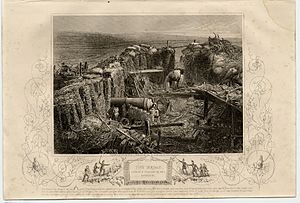
For his brave actions, he was thanked by General Raglan. He was even recommended for the Victoria Cross, a very high award for bravery. Sadly, this brave soldier died in the final attack on the Redan on September 8. He was 35 years old and left behind a wife and three young children.
The Russians left the Great Redan early in the morning of September 9.
Nova Scotians in the Siege of Sevastopol
- William Hall (VC) - Hall fought in the Crimean War. He served on land with a Naval Brigade from HMS Rodney at the battles of Inkerman and Sebastopol in 1854.
- William Blackman - From the HM 62nd Regt., he fought in the Battle of the Great Redan, the Battle of the Quarries, and the Siege of Sebastopol.
- John Wimburn Laurie
- Hedley Vicars - He was stationed in Halifax from 1851-1853.
- John James Snodgrass's son, Archibald Campbell Snodgrass, joined the 38th Regiment and worked for his uncle, Sir John Campbell, 2nd Baronet.
Admirals in Halifax
Four naval commanders who were part of the Siege of Sevastopol later lived in Halifax at the Admiralty House. They were:
-
Edward Augustus Inglefield, served in Halifax (1878–79)
-
John Edmund Commerell, he won the Victoria Cross for his actions in the Siege; served at Halifax (1882–85)
Legacy of the Monument
The Sebastopol Monument was built by George Lang, who also built the Federal Building in Halifax (now the Art Gallery of Nova Scotia). A huge, twelve-ton lion sits on top of the Roman-style arch. The arch and lion are made from sandstone from New Brunswick.
The monument was unveiled on July 17, 1860. Many people attended the ceremony, including volunteer soldiers, Masons, and public officials. The Lieutenant Governor, Lord Mulgrave, and other important figures spoke.
Major Welsford is remembered in several place names. Welsford, New Brunswick, and two places called Welsford in Nova Scotia are named after him. Alma, New Brunswick and Alma, Nova Scotia are named after the Crimean War Battle of Alma. Welsford Street and Parker Street in Halifax are also named to honor these two men.
At King's College, a prize is given each year to students in their first year. It's called the Almon-Welsford Testimonial Prize. It was started by Major Welsford's old friend, Dr. William Johnston Almon, to remember Welsford's brave deeds.
See also
 In Spanish: Monumento a Sebastopol para niños
In Spanish: Monumento a Sebastopol para niños


